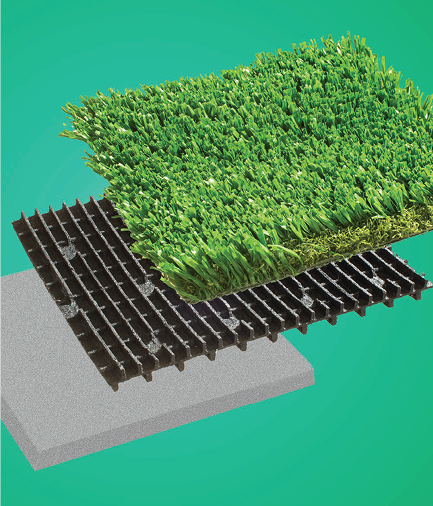5 Things You Didn't Know about Artificial Turf Drainage
Our Practices
When you walk onto a sports field, the seamless playing surface tells only part of the story. Beneath your feet lies a complex drainage system that's working around the clock to keep the field playable, safe, and long-lasting. While the turf infill is important, the real magic happens in the layers below, particularly with advanced shock drain pad technology that's revolutionizing how artificial turf performs.
If you’re in the market for a new sports field, here are five surprising facts about artificial turf drainage that highlight why proper drainage solutions are critical to field performance.

1. Traditional Stone Drainage Can Be Reduced by 75% with Modern Technology
Most people assume that artificial turf requires thick layers of drainage stone—typically 6 inches or more—to function properly. However, advanced engineered drainage solutions like En-Plast's Rock-in-Roll can reduce this requirement to just 2 inches, or in some cases, eliminate the need for drainage stone entirely.
This dramatic reduction isn't just about convenience—it represents a fundamental shift in how we approach turf installation. Traditional stone layers are heavy, expensive to transport, and require significant excavation. By using encapsulated SBR granules that efficiently channel water while providing structural support, modern drainage pads deliver superior performance with a fraction of the material requirements.
The implications extend beyond cost savings. Reduced excavation means less disruption to existing sites, faster installation times, and lower transportation costs—all while delivering better drainage performance than traditional methods.
2. Poor Drainage Doesn't Just Create Puddles—It Destroys the Entire Field System
When artificial turf drainage fails, the consequences cascade through every layer of the field system. By not draining properly, it saturates the sub-base, leading to settlement and uneven surfaces. The turf backing begins to delaminate, seams separate, and the infill system becomes contaminated with organic matter that promotes bacterial growth and odors. What starts as a drainage problem quickly becomes a complete field failure requiring expensive reconstruction.
This is why shock drain pads like ShockDrain 580 and KBA 780 are engineered for "maximum permeability." These systems don't just handle normal rainfall—they're designed to manage extreme weather events and prevent the catastrophic failures that occur when water has nowhere to go.
3. The Same System That Drains Water Also Protects Athletes from Injury
Shock drain pads serve a dual purpose: they channel water away from the playing surface while simultaneously providing critical impact attenuation that reduces injury risk. En-Plast's ShockDrain systems achieve HIC (Head Injury Criterion) ratings exceeding 1.6 meters, meaning they provide industry-leading shock absorption that significantly reduces the impact forces transmitted to athletes during play. This dual functionality is what makes modern shock drain technology so revolutionary—you're not choosing between drainage and safety, you're getting both from a single engineered solution.
The thermoplastic elastomer polyolefin composites (TEPC) used in these systems maintain their shock-absorbing properties even when saturated with water, ensuring consistent athlete protection regardless of weather conditions.
4. Modern Drainage Systems Are Designed for Climate Extremes You'd Never Expect
Artificial turf installations face weather conditions that would challenge any drainage system. From sudden cloudbursts that drop inches of rain in minutes to freeze-thaw cycles that can crack traditional materials, drainage systems must perform under extreme conditions.
En-Plast’s ShockDrain KBA 780 is specifically engineered to handle "hostile climate conditions" with confidence. The advanced TEPC materials maintain their structural integrity and drainage capacity across temperature extremes that would compromise traditional systems. This isn't just about handling more water—it's about maintaining consistent performance when conditions are at their worst.
This climate resilience is increasingly important as weather patterns become more unpredictable. A drainage system that performs well in normal conditions but fails during extreme weather events isn't really a reliable system at all.
5. The Most Advanced Drainage Technology Is Also the Most Environmentally Responsible
Sustainability in artificial turf drainage isn't just about using recycled materials—though En-Plast's products are manufactured from recycled materials and are 100% recyclable from cradle to cradle. The real environmental impact comes from water conservation and runoff management.
Traditional artificial turf installations often increase stormwater runoff, putting additional strain on municipal drainage systems. Advanced drainage pads like Rock-in-Roll actually help reduce runoff by improving water infiltration and supporting groundwater recharge. This is particularly important in urban environments where impervious surfaces already create drainage challenges.
The water conservation benefits extend to maintenance as well. Properly drained artificial turf requires less irrigation for cooling and dust control, reducing long-term water consumption. When you consider that these systems also repurpose end-of-life tires that would otherwise end up in landfills, the environmental benefits multiply across the entire product lifecycle.
Talk to En-Plast About Shock-Pads for Sports Fields
The next time you step onto an artificial turf field, remember that beneath your feet lies a sophisticated drainage system that's working invisibly to ensure peak performance. If you’re interested in learning more, En-Plast offers cutting-edge shock-pads for sports fields. Get a quote today.

Need More Info?
Want to learn more about how En-Plast can help your business? Click below to get in touch.